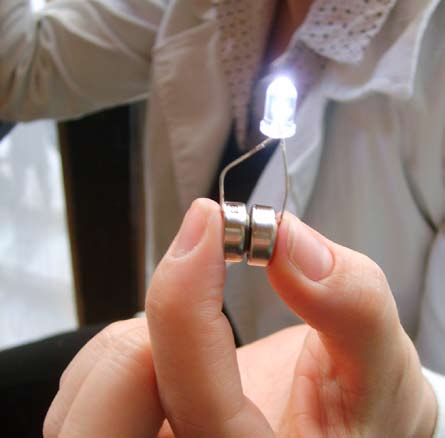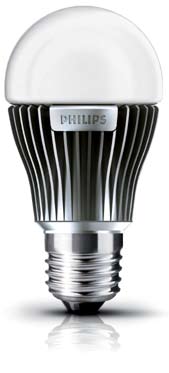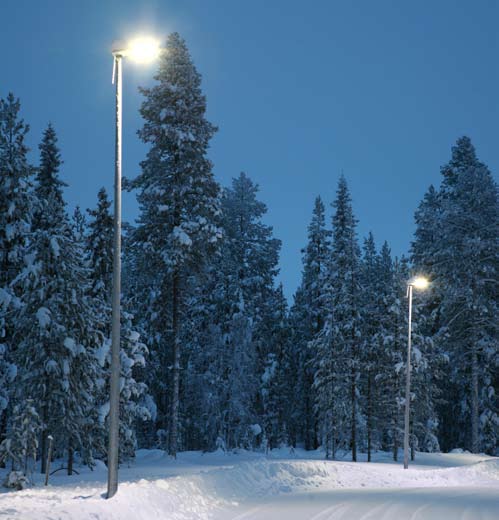
APRIL 2010: Do you remember the HP-35 calculator that Hewlett-Packard (HP) launched way back in 1972? It was a hot favourite amongst engineers, being the only pocket calculator with transcendental functions at that time. It cost $395, and believe it or not, the price tag was so heavy because the device used light-emitting diodes (LEDs)! Today, LEDs are used even by school children for their science projects—say, an experiment to light up little bulbs using a spinning magnet. That is how common these tiny ‘digital’ lights have become.
At a time when their cost was prohibitive, LEDs were used merely as indicators in electronic devices. The fact that these bud-like lights consumed very little power, gave out very little heat and had a long life made them very popular and led manufacturers to explore various other applications. They are now used as backlights for digital displays, including liquid crystal display (LCD) flat televisions and computer monitors, sustainable lighting systems such as solar lanterns and solar street lights, as well as conventional home lighting. Even as these applications slowly gain momentum, newer ones such as automotive lighting and mobile projection are cropping up.
This quick uptake of LED technology can be attributed to the fact that the industry has been keeping pace with Haitz’s Law—a prediction by an erstwhile HP employee called Ronald Haitz that the amount of light that can be produced per diode (performance) would increase twenty-fold every decade, while the cost of that light would decrease ten-fold.
Paul Thieken, director of marketing-LED Components, Cree, stresses that over the past 40 months or so, the performance of high-power LEDs has improved drastically. “The most exciting improvements are the greatly increased light output (flux), improved efficacy (lumens-per-watt) and the colour quality and stability. These improvements are exciting because they have enabled commercially-viable LED lighting solutions which are now available to the consumer,” he adds.
Commenting on other associated developments, Marion Reichl, press officer, OSRAM Opto Semiconductors GmbH, says, “There are several improvements within the last few years that have given LED technology a real drive… ceramic packages for better thermal management; increase in efficiency within a short timeframe, with the help of chip technologies; organic LEDs (OLEDs) as a light source of the future; long-life, high-brightness white LEDs with longer maintenance intervals and better total cost of ownership; and so on. These improvements sup-port the fast and extensive adoption of LEDs for different applications.”
“LED is an initiative towards lowering energy demand and consumption, through lower power consumption and higher output,” says Hari Chereddi, managing director, Sujana Energy Limited. In this regard, he remarks, “The three most exciting improvements have been in the areas of applicability, availability and affordability of LEDs from the perspective of a common man. Applicability to our day-to-day lighting needs, availability in most shapes and sizes and, most significantly, becoming affordable to all, thereby providing limitless opportunities for ‘linking light and life’… Sujana Energy sees this as one of the most exciting areas of growth.”
According to Ajay Goel, CEO, Goldwyn Limited, the payback period of LED-based lighting solutions with respect to conventional technologies is as follows:
1. Streetlights for the governments/municipalities: Immediate as the cost of putting up power plant (for the amount of power saved) will be more than the cost of LED streetlights
2. Office LED lights: 18 months to 36 months
3. Other LED lights: 30 months, on an average
So far so good, and it promises to better, as there is a lot of LED-related research happening across the world. “However, major LED manufacturers have the most expertise and also the largest resources to put towards research,” comments Thieken.
[stextbox id=”info” caption=”Did we say ‘digital’?”]
You heard it right. An LED is part and parcel of the digital world. In fact, it is a simple, little ‘chip’. Even the manufacturing process bears a lot of semblance to that of computer chips. A p-n (positive-negative) junction is created out of a suitable semiconductor material. When electrons flow from the anode to the cathode, they move to a lower energy level, emitting a photon of light. The light could be red, green, blue or amber depending on the materials used to make the diode. The light from different coloured LEDs may be combined or a blue LED lens may be coated with phosphor to make white light.
LEDs are used as components in electrical and electronic devices, as well as for larger applications such as automotive or home lighting.
[/stextbox]
Not alone, though, the research work is done in partnership, points out Reichl. OSRAM Opto Semiconductors has a broad network of partners in the scientific community with connections at universities and research institutes. The company is also active in projects supported by the public sector (and there is quite a lot of thrust from this front, as LEDs are a good solution to today’s power-guzzling lighting equipment).
Evidently, there is a shove from all directions to take LED technology forth. Here is a sample of what is happening and what is in store.
LED in your living room
Efforts are on make LEDs the de facto standard for home and public lighting. Although LED lights are still too costly to motivate the common man to go for them, power savings, long life and low maintenance requirements have resulted in companies opting for LED-based lighting systems for their offices. Today, the most efficient LEDs are about ten times more energy-efficient than incandescent bulbs.

Also, with LEDs, it is possible to develop solidstate lighting (SSL) products, that is, lamps made using LEDs and OLEDs rather than electrical filaments, plasma or gas. The light weight and no brittle parts make such lamps robust and shock-resistant. The lifespan is also longer. They are now used mostly for traffic lights, remote controls, etc, but soon they might rule the home lighting market.
While it might be a few more years before we replace all the bulbs at home with LED lamps, the process of phasing out the traditional energy-guzzling incandescent bulbs has already begun in several countries, including parts of Australia, Europe and South America. The United States of America is targeting 2012, and is even holding contests such as the L-Prize, to spur lighting manufacturers to develop high-quality, high-efficiency solidstate lighting products. 60W bulbs account for 50 per cent of the domestic incandescent market, and replacing these with LED bulbs would save enough electricity per year to light 17.4 million households. It would also avoid 5.6 million metric tonnes of carbon emissions annually. The US Department of Energy hopes this to be the outcome of the L-Prize.
A list of the 50 best inventions of 2009 published in TIME magazine in November 2009 included Philips’ entry to the L-Prize (which also happens to be the first entry to the contest). Philips’ LED bulb emits the same amount of light as its incandescent equivalent but uses less than 10 watts and lasts 25 times longer.
According to the press release, the Philips submission will now undergo comprehensive evaluation, including performance testing conducted by independent laboratories, field assessments conducted with utilities and other partners, long-term lumen maintenance testing and stress testing under extreme conditions. Consumer pricing and retail availability are yet to be determined.
Reichl shares, “The OSRAM Parathom Classic is the very first bulb-shaped LED lamp, which constitutes a true substitute for a 40W incandescent lamp. This move will speed up the advance of LED technology as a genuine alternative for general lighting applications.” The company is also aiming to develop and market an LED for SSL applications that offer a continuous spectrum, exactly like natural daylight.
The price of LED lamps is still prohibitive when one considers using them for the lighting needs of an entire house. Leading brands might cost more than $20 a piece, while Chinese alternatives are cheaper. Prices will inevitably fall, because the writing on the wall is clear—LEDs are the future of home lighting. Despite the high initial costs, commercial organisations worldwide have already started adopting LED-based lighting because of the low TCO it offers in the long run, as well as to meet energy-related regulations.
India will also walk in step with the LED revolution happening worldwide. “We strongly believe that standardisation of LED lighting in India is a pre-requisite to prepare the market for the launch of superior products. To sustain this effort, Sujana Energy is working with bodies like the Bureau of Energy Efficiency (BEE) to help define LED luminaire specifications to meet global standards in India,” says Chereddi.
LED-lit towns
LEDs are a great option for street lighting, because these are economically and environmentally sustainable. By moving to LEDs, a town can save lots of power, avoid a lot of carbon emission and also reduce the total cost of ownership because LEDs have a long life and are practically maintenance-free.

The first example of this kind was the Italian village of Torraca, which spent 280,000 Euros to convert all its street lamps into LED lamps, reducing their energy and maintenance costs by 70 per cent. The City of Ann Arbor in the US followed suit and replaced a few thousand streetlights. The authorities noted an energy cost saving of around $10,000 and an additional $40,000 in maintenance costs last year from using LED lights instead of incandescent streetlights. The city therefore plans to replace more of its streetlights by next year.
[stextbox id=”info”]
LEDs are a great option for street lighting, because these are economically and environmentally sustainable. By moving to LEDs, a town can save lots of power, avoid a lot of carbon emission and also reduce the total cost of ownership
[/stextbox]





